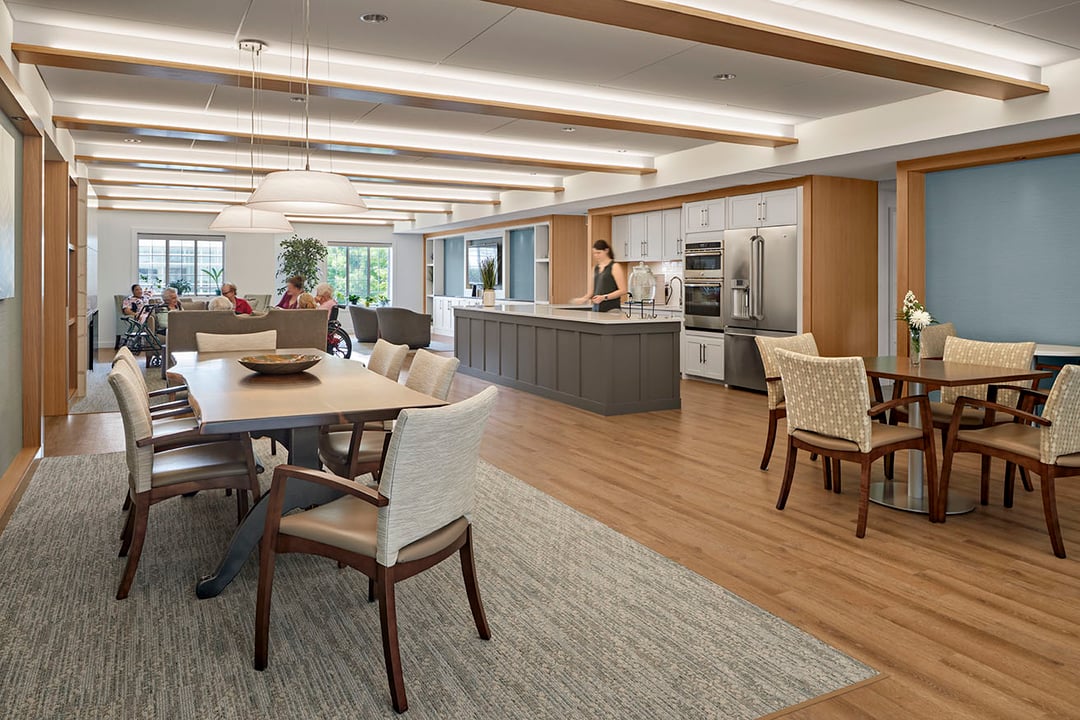Once upon a time, people lived their entire lives in their home, often the same family home. Today, that’s rarely the case. Evolving lifestyles and family structures precipitated development of a range of specialized living environments for seniors. Each serves a specific population as people need different levels of support, which means each requires different design parameters to meet those needs.
As a director of Healthcare for almost 10 years at Mannington Commercial and over 35 years worth of experience in building product sales, the majority of which has been focused in healthcare, you could say I have a passion for healthcare and improving the built environment.
I have also learned a lot as a “consumer” of senior living. My 94-year-old father has lived in a Continuing Care Retirement Community (CCRC) for over a decade, and his views on aging and good design for the senior environment have really helped broaden my understanding.
Ongoing innovations and societal transitions have greatly impacted available options for seniors and overall design capabilities.
Let’s talk about the seven social trends that are affecting senior living:

Aging in Place
Aging in place is just what it sounds like, staying in your own home for as long as you can. People like to retain their independence in a place where they are comfortable and already have relationships. It can feel safer and simpler than making a change.
Three-quarters of Americans age 50 and older say they want to live in their own homes for the rest of their lives but less than half of those believe that’s really possible.
That makes it necessary to create alternative environments that make people feel at home, like they belong. In some cases, there are Continuing Care Retirement Communities (CCRCs) or similar communities so people can transition through necessary stages of care in the same place.
My dad lives in a CCRC called Beaumont in Bryn Mawr, PA. Beaumont offers villas for independent living, apartments for independent transitional living, and a health center for an increased level of care. While he lives independently now in a villa on the property, my family and I have the peace of mind knowing that, if needed, Dad has optional modes of care as he continues to age.
For many, those communities aren’t viable, either because of finances or other circumstances which drives innovators to continually come up with new options and services to meet their needs.
Technology will assist aging in place with wearable items that can alert when a senior deviates from their normal daily pattern. For example, your parent living alone may normally wake up around 8am, eat breakfast and then read or watch TV until late morning. When Mom or Dad deviates from this pattern, wearable technology can alert the adult child to give Mom or Dad a call to check in and make sure everything is OK.
Embedded technology can also be used to help seniors age in place. Sensors and microprocessors in appliances, furniture, and clothing collect data that is analyzed and can be used to diagnose diseases and recognize risk patterns. Home automation (“Smart Home” technology) in homes of older adults can help to maintain their independence and safety, also saving the costs and anxiety of moving to a healthcare facility.
Holistic Spaces
The idea that “it takes a village” doesn’t just apply to children. The idea of multigenerational functional spaces applies to seniors as well. A holistic approach to senior living incorporates a wide range of wellness functions ranging from physical fitness to social activities. A natural environment can be healing and counteract any sense of a clinical feel.
Multigenerational communities help to avoid the isolation and stigmatization of seniors. Some senior communities have included popular retailers to encourage young people to interact with the senior community. Garden Spot Village in New Holland, PA, for example, has a Starbucks inside their main building which serves as a focal point for residents of many generations to come together and learn from each other.
Related: Designing Senior Living Facilities to Support the Aging Population
Grandparenting
In the last decade, there was more than a 30 percent increase in full-time grandparenting. That’s grandparents who raise their grandchildren as the primary caretaker. According to 2010 U.S. Census data, 4.9 million American children are being raised solely by their grandparents. There are a lot of reasons why this is happening including economics.
Economic factors play into one of the living options that’s developed from this trend – multi-family housing communities where all the residents benefit from shared amenities and services. This can be a way to share the positives and the tougher parts of the situation.
Millennials
A major shift in the American household in the last decade involves those born between 1980 and 2000 either never leaving or moving back home. That living arrangement means they are assuming more responsibilities in the home.
Currently 83% of families become caregivers and, of these 40 million caregivers, one in four is a Millennial. As the number of professional senior caregivers continues to decline, millennials caring for seniors is helping to make up the deficit.
All these concepts support an expanded sense of community and support universal design principles that emphasize optimum functionality for all ages. Inclusive design is a process that enables and empowers a diverse population by improving human performance, health & wellness, and social participation. Our goal is to create opportunities for people to be independent and live a full life.
Even changes in the Medicare Advantage Plans for 2020 can make it easier for seniors to access in-home health and wellness services. And revised policies can enable better outcomes. Innovations such as telemedicine and remote monitoring devices make it more feasible for people to receive care wherever they choose to live.
You Might Like: A Guide To Understanding the Fundamentals of Healthcare Flooring
How Do Lifestyle Decisions Factor Into Design?
Design and construction of living spaces is complex no matter the target audience. Addressing the needs of an aging population adds another level of complication. A number of factors impact housing for this group.
A Growing Number of Renters
According to the U.S. Census Bureau, the percentage of Americans age 55 and older choosing to rent increased 28% between 2009 and 2015, adding approximately 2.5 million renters to the market.
There are multiple contributing factors: some people want more carefree living while others were negatively affected by the economic crash of 2008 and couldn’t afford to downsize into a home. Yet another is the alarming number of seniors living below the poverty line, which is driving a coordinated push for more affordable rental housing.
And the type of rental housing may look different than what we would expect. For example, aging Baby Boomers are looking for more unique forms of senior living than traditionally offered.
Options such as AirBnB appeal to many as seniors can live in different parts of the United States, even different parts of the world, for several months at a time. Cruise ships are also options that many seniors consider in lieu of owning a home. Seeing the world without owning a permanent home appeals to many aging adults.
Communal Living
There’s a percentage of the aging population who doesn’t want to live alone but doesn’t need the services of assisted living. This group is choosing communal living. Residents have their own bed and sometimes a bath while enjoying the benefits of living with other people who aren’t family members.
Garden Spot Village, mentioned previously, offers the option of group homes. This is appealing for those that want the social interaction of living with others and sharing tasks while also being a more affordable solution. It can be a wonderful solution if the space is well designed to meet the needs of both individuals and the group. And imagine the enrichment of including multi-generational living along with communal living and how all groups could benefit.
Pet Ownership
Another lifestyle factor involves a different kind of family member – one with four legs and fur. More than 25 million Baby Boomers have at least one pet, prompting more than 78 percent of senior living communities to be pet-friendly. Creating an environment that’s hospitable for pets includes outside access for walks, dog parks and grooming stations.
It can also include aquariums, chicken coops or aviaries. Whether it’s a cat, a dog, a bunny or a fish, a home needs to be hospitable and accommodating to pet ownership for a senior to enjoy the myriad benefits of having a pet including increased social interaction, brain function, physical activity and lowered blood pressure.
Some facilities have automated “pets” that can be placed in a resident’s lap so they experience the health benefits without the responsibility of a living animal. Many have heart beats, are warm to the touch, and make soothing purrs or barks. This is especially helpful in memory care facilities where pet ownership is not practical.
My mother-in-law was a resident of the memory care unit at The Palms at Ponte Vedra . They had a “cat” that residents were able to hold in their laps and soothingly pet-it even purred! I thought it was real the first time I saw it! Needless to say, the comfort and calm provided by this “pet” was very helpful to my mother-in-law and her friends in memory care.
What Will the Future Hold for Senior Living?
The future of senior living may contain models we haven’t encountered yet, or encompass several models blended together. For example, in the recent COVID-19 pandemic, many seniors who were Aging in Place felt isolated and lonely-and the mental health effects from such feelings often have a detrimental effect on physical health.
Will seniors want to move into places such as CCRCs to feel more safe and secure? Or will Holistic Living and Communal Living become more popular, perhaps blended in with multigenerational families?
One thing is for sure: we need to offer our seniors safe, comfortable environments in which to age with dignity and grace.
Would you like to learn more about Senior Living and earn AIA/IDCEC CEU credits?
We have a CEU for you. 👇


